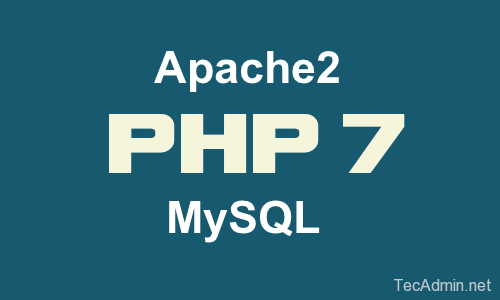Recommended Article:

1. Setup Yum Repository
In the first step install all the required yum repositories in your system used in remaining tutorial for various installations. You are adding REMI, EPEL, Webtatic & MySQL community server repositories in your system.CentOS / RHEL 7
# yum install epel-release # rpm -Uvh http://rpms.famillecollet.com/enterprise/remi-release-7.rpm # rpm -Uvh https://mirror.webtatic.com/yum/el7/webtatic-release.rpm # rpm -Uvh http://repo.mysql.com/mysql-community-release-el7-5.noarch.rpm
CentOS / RHEL 6
# yum install epel-release # rpm -Uvh http://rpms.famillecollet.com/enterprise/remi-release-6.rpm # rpm -Uvh https://mirror.webtatic.com/yum/el6/latest.rpm # rpm -Uvh http://repo.mysql.com/mysql-community-release-el6-5.noarch.rpm
2. Install PHP 7
Now install php 7 packages from webtatic rpm repository using following command.# yum install php70wNow install required php modules. Use following command to list available modules in yum repositories.
# yum search php70wNow check all listed modules in above command and install required modules like below.
# yum install php70w-mysql php70w-xml php70w-soap php70w-xmlrpc # yum install php70w-mbstring php70w-json php70w-gd php70w-mcryptAfter installing php and other php modules restart Apache service.
# systemctlrestart httpd.service
3. Install Apache 2.4
Apache (HTTPD) is the most popular web server used on Linux systems. Let’s install Apache web server using following command with enabling epel and remi yum repositories.# yum --enablerepo=Now start httpd service and enable to start on boot using below commands.epel,remi install httpd
# systemctlstart httpd.service # systemctlenable httpd.service
4. Install MySQL 5.6
In step 1 we already have installed required yum repository in your system. Lets use following command to install MySQL server on your system.# yumApply security on mysql and also set root user password.install mysql-server
# systemctlNow restart MySQL service and enable to start on system boot.start mysqld.service # mysql_secure_installation
# systemctlrestart mysqld.service # systemctlenable mysqld.service
5. Open Port in Firewall
Finally open firewall ports for http (80) and https (443) services using following command.# firewall-cmd --permanent --zone=public --add-service=http # firewall-cmd --permanent --zone=public --add-service=https # firewall-cmd --reload
6. Check Installed Version
Let’s check the installed versions of packages on system using following commands one by one.#php -v PHP 7.0.0 (cli) (built: Dec 2 2015 20:42:32) ( NTS ) Copyright (c) 1997-2015 The PHP Group Zend Engine v3.0.0, Copyright (c) 1998-2015 Zend Technologies
#httpd -v Server version:Apache/2.4.6 (CentOS) Server built: Nov 19 2015 21:43:13
#Now you have successfully configured LAMP setup on your CentOS / RHEL 7.1 & 6.7 system.mysql -V mysql Ver 14.14 Distrib5.6.28 , for Linux (x86_64) using EditLine wrapper
Recommended Article:
Comments
Post a Comment